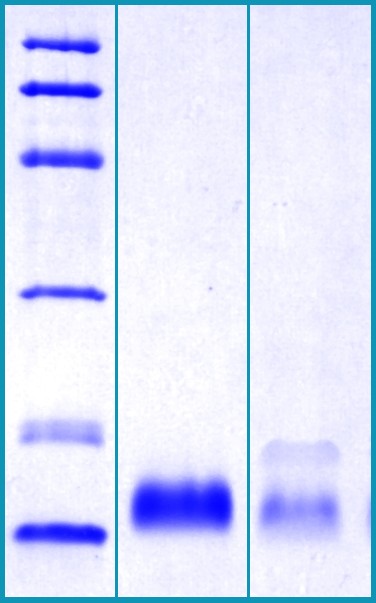Type
Recombinant protein
Description
Total 104 AA. MW: 11.3 kDa (calculated). UniProtKB acc.no. Q14508 (Glu31-Phe124). N-terminal 10 extra AA. Protein identity confirmed by MS.
Amino Acid Sequence
MKHHHHHHASEKTGVCPELQADQNCTQECVSDSECADNLKCCSAGCATFCSLPNDKEGSCPQVNINFPQLGLCRDQCQVDSQCPGQMKCCRNGCGKVSCVTPNF
Source
E. coli
Purity
˃ 90 % by SDS-PAGE
SDS-PAGE Gel
14 % SDS-PAGE separation of Human HE4:
1. M.W. marker – 14, 21, 31, 45, 66, 97 kDa
2. reduced and boiled sample, 2.5 μg/lane
3. non-reduced and non-boiled sample, 2.5 μg/lane
Endotoxin
< 1.0 EU/µg
Formulation
Filtered (0.4 μm) and lyophilized in 0.5 mg/mL in PBS buffer, pH 7.5, 4%mannitol, 1%sucrose
Reconstitution
Add 200 µl of deionized water to prepare a working stock solution of approximately 0.5 mg/ml and let the lyophilized pellet dissolve completely.
Applications
Western blotting, ELISA
Shipping
At ambient temperature. Upon receipt, store the product at the temperature recommended below.
Storage/Expiration
Store the lyophilized protein at -80 °C. Lyophilized protein remains stable until the expiry date when stored at -80 °C. Aliquot reconstituted protein to avoid repeated freezing/thawing cycles and store at -80 °C for long term storage. Reconstituted protein can be stored at 4 °C for a week.
Quality Control Test
BCA to determine quantity of the protein.
SDS PAGE to determine purity of the protein.
Endotoxin level determination.
Note
This product is intended for research use only.
Research topic
Oncology
Summary
Human epididymis protein 4 (HE4), also called whey-acidic-protein (WAP) four-disulfide core domain protein 2 (WFDC2) is a secreted 25 kDa glycoprotein, a member of the WAP family, initially described to have tissue specific expression in the epididymis. Clinical research in the last decade revealed that HE4 is expressed in a limited number of other organs, including female reproductive tract, breast tissue, kidney, regions of the respiratory tract and nasopharynx. The gene encoding HE4, WFDC2, is composed by six exons. Five HE4 isoforms have been identified and recognized to define specific patterns differently expressed in neoplasm and normal tissues. Under physiologic conditions, HE4 is reported as protease inhibitor playing a crucial role in sperm maturation. The protein contains a WAP domain (4-disulfide core domain 2), which is known to occur in antiproteinases and proteins involved in the innate immune defense of multiple epithelia. Some studies have reported a potential role in the innate immunity of the oral cavity and respiratory tract. In pathophysiology, HE4 is likely involved in cancer progression and metastases. The protein is highly over expressed in epithelial ovarian cancer (EOC) compared to normal ovarian epithelium which is in agreement with clinical studies showing up regulation of HE4 levels in women with EOC. Since its clinical relevance has been confirmed, the HE4 is a biomarker for the detection of ovarian cancer in women with an ovarian cyst or pelvic mass as part of the Risk of Ovarian Malignancy Algorithm (ROMA) and for monitoring women diagnosed with EOC. Amongst the newly proposed biomarkers for ovarian cancer, serum human epididymis protein 4 shows the greatest potential for clinical use.
Product Datasheet (RUO)
Datasheet PDF (RUO)
Datasheet PDF (RUO)
Safety Information (RUO)
MSDS (RUO)
Find documents for the lot

